
Cosmos bipinnatus, commonly called the garden cosmos or Mexican aster, is a medium-sized flowering herbaceous plant in the daisy family Asteraceae, native to the Americas. The species and its varieties and cultivars are popular as ornamental plants in temperate climate gardens.

The Guatemalan black howler, or Yucatan black howler, is a species of howler monkey, a type of New World monkey, from Central America. It is found in Belize, Guatemala and Mexico, in and near the Yucatan Peninsula. It lives in evergreen, semideciduous and lowland rain forests. It is also known as the baboon in Belize, although it is not closely related to the baboons in Africa.

The Mexican long-tongued bat is a species of bat in the family Phyllostomidae. It is monotypic within the genus Choeronycteris. The species is found in El Salvador, Guatemala, Honduras, Mexico, and the United States.
Lippia substrigosa is a plant from the family Verbenaceae that is native to Central and South America. It can grow as either a shrub or a tree up to 7 metres (23 ft) tall and can be burned to produce fuel. Its essential oil may have pharmaceutical or cosmetic uses.
Pilosella friesii – not to be confused with the European P. schultesii – is a North American plant species in the dandelion tribe within the sunflower family. It is widespread across much of Mexico with a few populations in Guatemala and western Texas.
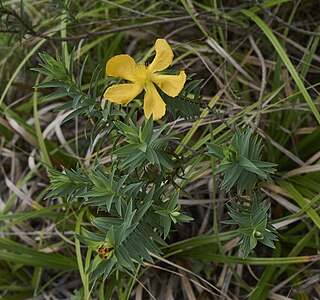
Hypericum terrae-firmae is a woody perennial flowering plant in the St. John's wort family Hypericaceae. It is an endemic plant species of Belize.

Leucadendron salignum, also known as the common sunshine conebush, is an evergreen, dioecious shrub that produces several stems from the ground of up to 2 metres high; forming part of the genus Leucadendron from the family Proteaceae. It survives the wildfires that occur every one or two decades in the fynbos where it occurs by regrowing from an underground rootstock. Pollinated by beetles, it flowers from April to November. The winged seeds remain in the woody cones until they are released after a fire, and are distributed by the wind. It is possibly the most common Proteaceae species in South Africa, and can be found in the Northern Cape, Western Cape and Eastern Cape provinces. Its current conservation status is Least Concern.

Leucospermum saxosum is an upright evergreen shrub of up to 2 m (6.6 ft) high, that is assigned to the family Proteaceae. It has lance-shaped, leathery leaves and egg-shaped flower heads of about 5 cm (2.0 in) in diameter, with initially yellow-orange flowers, later turning crimson, from which long styles stick out, giving the flower head the appearance of a pincushion. It is called escarpment pincushion in English. It grows on quartzite soils in the mountains on the Zimbabwe-Mozambique border and in eastern Transvaal.
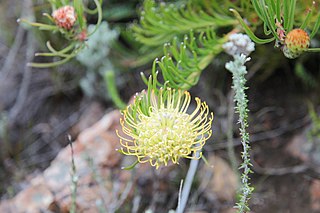
Leucospermum lineare is an evergreen shrub with linear leaves and is assigned to the Proteaceae. There are two distinct forms that have not been formally recognized as separate taxa. There is an upright form with orange flower heads of up to 2 m (6.6 ft) high, and a sprawling form of 2–3 m (6.6–9.8 ft) in diameter with yellow flower heads. Its common name is needle-leaf pincushion, or narrow-leaf pincushion, in English and smalblaarspeldekussing in Afrikaans. The orange-flowered form is called tangerine pincushion or assegaaibos pincushion. Flowering occurs in the first half of the southern hemisphere season, but peaks in September and October. It is an endemic species that can only be found in the southwest of the Western Cape province of South Africa.
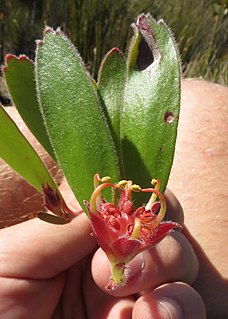
Leucospermum hamatum is mat-forming, evergreen shrublet of only about 10 cm (3.9 in) high, from the Proteaceae. It is usually 1–3 m (3.3–9.8 ft) in diameter, has long trailing stems and upright, inverted lance-shaped, entire leaves but for one to five shallow reddish bony teeth near the tip. Its small flower heads of 1½–2 cm (0.6–0.8 in) in diameter, consist of four to seven drab carmine-colored flowers that strongly curve back to the centre of the head. It mainly flowers from July till November and is pollinated by mice. It has been given the common name Ruitersbos pincushion.

Leucospermum tomentosum is an evergreen, mostly spreading shrublet of approximately 75 cm (3 ft) high and up to 3 m (10 ft) in diameter, with alternately set, linear or narrowly spade-shaped, grey felty leaves, with one to three teeth near the tip. It has round, seated flower heads of 3–3½ cm (1.2–1.4 in) in diameter, occurring in groups of one to four, and consisting of deep yellow, very sweet scented flowers. It can survive the occasional wildfire because it regenerates from the underground rootstock. It is an endemic species that is restricted to a narrow strip along the Atlantic coast of the Western Cape province of South Africa. The species flowers between June and November. It is called Saldanha pincushion in English.

Leucospermum heterophyllum is a low, trailing evergreen shrublet of up to 15 cm (6 in) high, and up to several m in diameter, which is assigned to the family Proteaceae. It has narrow leaves of about 2½ cm (1 in) long and ½ cm (0.2 in) wide, mostly with three teeth near its tip. It has small, globe-shaped, whitish flower heads. It is called trident pincushion in English and rankluisie in Afrikaans. It naturally occurs in the Western Cape province of South Africa. The plant flowers between August and January.

Leucospermum grandiflorum is an evergreen, upright shrub of up to 2½ m high that is assigned to the family Proteaceae. It has elliptic, greyish green, softly hairy leaves and initially egg-shaped heads with yellow flowers, later flatter with flowers turning orange. From the center of each flower emerges a long pale yellow style with a pink thickened tip that is bent slightly clockwise, giving the entire head the appearance of a pincushion. Its flowers can be found between July and December. It is called grey-leaf fountain-pincushion or rainbow pincushion in English. L. grandiflorum is an endemic species that can only be found in nature in the Western Cape province of South Africa.

Leucospermum patersonii is a large evergreen, upright shrub of up to 4 m (13 ft) high that is assigned to the family Proteaceae. It has large, roundish hairless leaves with three to eight teeths and egg- to globe-shaped, orange flower heads of 8–9 cm (3.2–4.0 in) across. From the center of each flower emerges a long orange style with a thickened tip that is bent to the center of the head, giving the entire head the appearance of a pincushion. It is called silveredge pincushion in English. Flowers can be found between August and December. It is an endemic species limited to the south coast of the Western Cape province of South Africa.
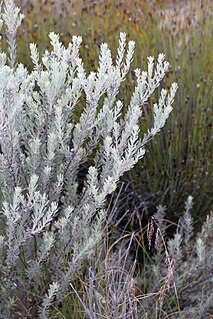
Leucospermum royenifolium is an evergreen, spreading or somewhat upturning shrub of up to ½ m high and 1–3 m (3–10 ft) in diameter from the family Proteaceae. It has patent elliptic, eventually hairless leaves. The flower heads are globe-shaped, 1–2 cm (0.4–0.8 in) in diameter, and contain initially whitish, later pinkish, sweetly scented flowers. From the center of the flowers emerge almost straight styles that jointly give the impression of a pincushion. It is called eastern pincushion in English. It can be found flowering between July and December. It occurs in the Western Cape and Eastern Cape provinces of South Africa.
Leucospermum profugum is an evergreen shrub of up to 8 m (25 ft) in diameter, with at base leafless main branches, that trail over the surrounding vegetation and rock, from the family Proteaceae. It has hairless and leathery inverted lance-shaped to oblong leaves tipped with mostly three or four teeth and flattened egg-shaped flowerheads of 9–12 cm (3.6–4.8 in) in diameter, that consist of initially yellowish orange flowers that later changing to salmon pink. From the center of the flowers emerge almost straight styles that jointly give the impression of a pincushion. It is called Piketberg pincushion in English. Flower heads can be found between late September and December. It is an endangered species, only known from three close locations in the Western Cape province of South Africa.

Leucospermum spathulatum is an evergreen, spreading and mat-forming shrub, that has been assigned to the family Proteaceae. It has inverted egg-shaped to spade-shaped mostly greyish softly hairy leaves, mostly without teeth and flattened globe-shapec flower heads of 5–7 cm (2.0–2.8 in) across, consisting of deep orange to crimson flowers, the bud and the style curving toward the center. It can be found in the Western Cape province of South Africa. The common name in English is Cederberg pincushion. It flowers between September and January, with a peak at the end of October.

Vexatorella alpina, the Kamiesberg vexator, is an evergreen, upright shrub of up to about 1½ m high, in the family Proteaceae. It has entire, long inverted egg-shaped, bluish grey, leathery leaves of 3–4½ cm (1.2–1.8 in) long and 5–13 mm (0.2–0.5 in) wide on a distinct stalk, and globular flower heads of about 2 cm (0.8 in) across at the tip of the branches, and consisting of pale pink flowers with extended, thick-tipped styles. The plants are flowering from September to November. It is an endemic species that is restricted to the Kamiesberge in South Africa.

Vexatorella amoena, also known as the Swartruggens vexator is an evergreen shrub of up to about 1 m (3 ft) high, that is assigned to the family Proteaceae. It has entire, inverted egg-shaped, bluish grey, leathery leaves of 1½–3 cm (0.6–1.2 in) long and 5–11 mm (0.20–0.45 in) wide on a distinct stalk, and globular flower heads of about 2 cm (0.8 in) across with pale pink flowers with extended, thick-tipped styles at the tip of the branches. The plants are flowering from September to November. It is an endemic species that is restricted to the Western Cape province of South Africa.
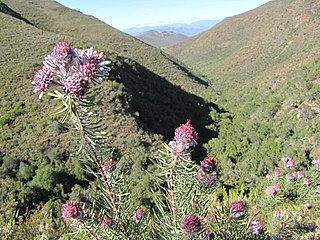
Vexatorella latebrosa, also known as the Robertson vexator, is an evergreen, upright shrub of up to about 1½ m high, from the family Proteaceae. It has entire, long inverted egg-shaped, bluish grey, leathery leaves that are line-shaped to very narrowly spade-shaped in outline, 5–6½ cm (2.0–2.6 in) long and 2–3 mm (0.08–0.12 in), and mostly solitary globular flower heads at the end of the branches of 2½–3 cm (0.8 in) across with scented, pink to carmine flowers with extended, styles with a thickened tip. The plants are flowering from August to September. It is an endemic species that is restricted to the Western Cape province of South Africa.

















